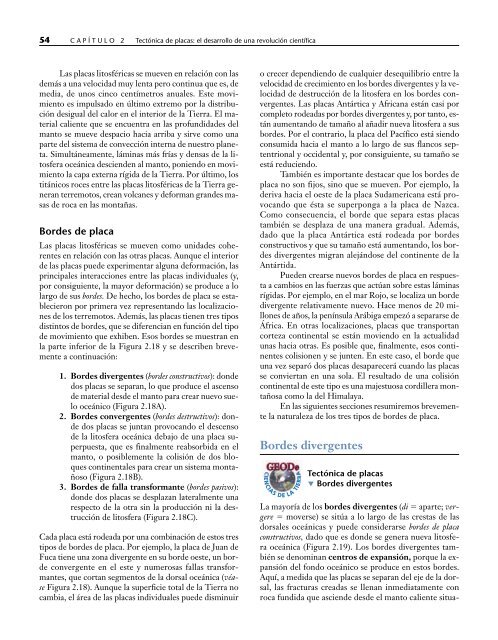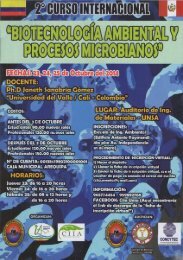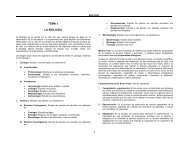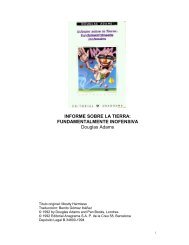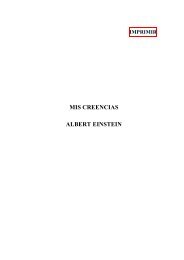You also want an ePaper? Increase the reach of your titles
YUMPU automatically turns print PDFs into web optimized ePapers that Google loves.
54 CAPÍTULO 2 Tectónica <strong>de</strong> p<strong>la</strong>cas: el <strong>de</strong>sarrollo <strong>de</strong> una revolución científica<br />
Las p<strong>la</strong>cas litosféricas se mueven en re<strong>la</strong>ción con <strong>la</strong>s<br />
<strong>de</strong>más a una velocidad muy lenta pero continua que es, <strong>de</strong><br />
media, <strong>de</strong> unos cinco centímetros anuales. Este movimiento<br />
es impulsado en último extremo por <strong>la</strong> distribución<br />
<strong>de</strong>sigual <strong>de</strong>l calor en el interior <strong>de</strong> <strong>la</strong> <strong>Tierra</strong>. El material<br />
caliente que se encuentra en <strong>la</strong>s profundida<strong>de</strong>s <strong>de</strong>l<br />
manto se mueve <strong>de</strong>spacio hacia arriba y sirve como una<br />
parte <strong>de</strong>l sistema <strong>de</strong> convección interna <strong>de</strong> nuestro p<strong>la</strong>neta.<br />
Simultáneamente, láminas más frías y <strong>de</strong>nsas <strong>de</strong> <strong>la</strong> litosfera<br />
oceánica <strong>de</strong>scien<strong>de</strong>n al manto, poniendo en movimiento<br />
<strong>la</strong> capa externa rígida <strong>de</strong> <strong>la</strong> <strong>Tierra</strong>. Por último, los<br />
titánicos roces entre <strong>la</strong>s p<strong>la</strong>cas litosféricas <strong>de</strong> <strong>la</strong> <strong>Tierra</strong> generan<br />
terremotos, crean volcanes y <strong>de</strong>forman gran<strong>de</strong>s masas<br />
<strong>de</strong> roca en <strong>la</strong>s montañas.<br />
Bor<strong>de</strong>s <strong>de</strong> p<strong>la</strong>ca<br />
Las p<strong>la</strong>cas litosféricas se mueven como unida<strong>de</strong>s coherentes<br />
en re<strong>la</strong>ción con <strong>la</strong>s otras p<strong>la</strong>cas. Aunque el interior<br />
<strong>de</strong> <strong>la</strong>s p<strong>la</strong>cas pue<strong>de</strong> experimentar alguna <strong>de</strong>formación, <strong>la</strong>s<br />
principales interacciones entre <strong>la</strong>s p<strong>la</strong>cas individuales (y,<br />
por consiguiente, <strong>la</strong> mayor <strong>de</strong>formación) se produce a lo<br />
<strong>la</strong>rgo <strong>de</strong> sus bor<strong>de</strong>s. De hecho, los bor<strong>de</strong>s <strong>de</strong> p<strong>la</strong>ca se establecieron<br />
por primera vez representando <strong>la</strong>s localizaciones<br />
<strong>de</strong> los terremotos. A<strong>de</strong>más, <strong>la</strong>s p<strong>la</strong>cas tienen tres tipos<br />
distintos <strong>de</strong> bor<strong>de</strong>s, que se diferencian en función <strong>de</strong>l tipo<br />
<strong>de</strong> movimiento que exhiben. Esos bor<strong>de</strong>s se muestran en<br />
<strong>la</strong> parte inferior <strong>de</strong> <strong>la</strong> Figura 2.18 y se <strong>de</strong>scriben brevemente<br />
a continuación:<br />
1. Bor<strong>de</strong>s divergentes (bor<strong>de</strong>s constructivos): don<strong>de</strong><br />
dos p<strong>la</strong>cas se separan, lo que produce el ascenso<br />
<strong>de</strong> material <strong>de</strong>s<strong>de</strong> el manto para crear nuevo suelo<br />
oceánico (Figura 2.18A).<br />
2. Bor<strong>de</strong>s convergentes (bor<strong>de</strong>s <strong>de</strong>structivos): don<strong>de</strong><br />
dos p<strong>la</strong>cas se juntan provocando el <strong>de</strong>scenso<br />
<strong>de</strong> <strong>la</strong> litosfera oceánica <strong>de</strong>bajo <strong>de</strong> una p<strong>la</strong>ca superpuesta,<br />
que es finalmente reabsorbida en el<br />
manto, o posiblemente <strong>la</strong> colisión <strong>de</strong> dos bloques<br />
continentales para crear un sistema montañoso<br />
(Figura 2.18B).<br />
3. Bor<strong>de</strong>s <strong>de</strong> fal<strong>la</strong> transformante (bor<strong>de</strong>s pasivos):<br />
don<strong>de</strong> dos p<strong>la</strong>cas se <strong>de</strong>sp<strong>la</strong>zan <strong>la</strong>teralmente una<br />
respecto <strong>de</strong> <strong>la</strong> otra sin <strong>la</strong> producción ni <strong>la</strong> <strong>de</strong>strucción<br />
<strong>de</strong> litosfera (Figura 2.18C).<br />
Cada p<strong>la</strong>ca está ro<strong>de</strong>ada por una combinación <strong>de</strong> estos tres<br />
tipos <strong>de</strong> bor<strong>de</strong>s <strong>de</strong> p<strong>la</strong>ca. Por ejemplo, <strong>la</strong> p<strong>la</strong>ca <strong>de</strong> Juan <strong>de</strong><br />
Fuca tiene una zona divergente en su bor<strong>de</strong> oeste, un bor<strong>de</strong><br />
convergente en el este y numerosas fal<strong>la</strong>s transformantes,<br />
que cortan segmentos <strong>de</strong> <strong>la</strong> dorsal oceánica (véase<br />
Figura 2.18). Aunque <strong>la</strong> superficie total <strong>de</strong> <strong>la</strong> <strong>Tierra</strong> no<br />
cambia, el área <strong>de</strong> <strong>la</strong>s p<strong>la</strong>cas individuales pue<strong>de</strong> disminuir<br />
o crecer <strong>de</strong>pendiendo <strong>de</strong> cualquier <strong>de</strong>sequilibrio entre <strong>la</strong><br />
velocidad <strong>de</strong> crecimiento en los bor<strong>de</strong>s divergentes y <strong>la</strong> velocidad<br />
<strong>de</strong> <strong>de</strong>strucción <strong>de</strong> <strong>la</strong> litosfera en los bor<strong>de</strong>s convergentes.<br />
Las p<strong>la</strong>cas Antártica y Africana están casi por<br />
completo ro<strong>de</strong>adas por bor<strong>de</strong>s divergentes y, por tanto, están<br />
aumentando <strong>de</strong> tamaño al añadir nueva litosfera a sus<br />
bor<strong>de</strong>s. Por el contrario, <strong>la</strong> p<strong>la</strong>ca <strong>de</strong>l Pacífico está siendo<br />
consumida hacia el manto a lo <strong>la</strong>rgo <strong>de</strong> sus f<strong>la</strong>ncos septentrional<br />
y occi<strong>de</strong>ntal y, por consiguiente, su tamaño se<br />
está reduciendo.<br />
También es importante <strong>de</strong>stacar que los bor<strong>de</strong>s <strong>de</strong><br />
p<strong>la</strong>ca no son fijos, sino que se mueven. Por ejemplo, <strong>la</strong><br />
<strong>de</strong>riva hacia el oeste <strong>de</strong> <strong>la</strong> p<strong>la</strong>ca Sudamericana está provocando<br />
que ésta se superponga a <strong>la</strong> p<strong>la</strong>ca <strong>de</strong> Nazca.<br />
Como consecuencia, el bor<strong>de</strong> que separa estas p<strong>la</strong>cas<br />
también se <strong>de</strong>sp<strong>la</strong>za <strong>de</strong> una manera gradual. A<strong>de</strong>más,<br />
dado que <strong>la</strong> p<strong>la</strong>ca Antártica está ro<strong>de</strong>ada por bor<strong>de</strong>s<br />
constructivos y que su tamaño está aumentando, los bor<strong>de</strong>s<br />
divergentes migran alejándose <strong>de</strong>l continente <strong>de</strong> <strong>la</strong><br />
Antártida.<br />
Pue<strong>de</strong>n crearse nuevos bor<strong>de</strong>s <strong>de</strong> p<strong>la</strong>ca en respuesta<br />
a cambios en <strong>la</strong>s fuerzas que actúan sobre estas láminas<br />
rígidas. Por ejemplo, en el mar Rojo, se localiza un bor<strong>de</strong><br />
divergente re<strong>la</strong>tivamente nuevo. Hace menos <strong>de</strong> 20 millones<br />
<strong>de</strong> años, <strong>la</strong> penínsu<strong>la</strong> Arábiga empezó a separarse <strong>de</strong><br />
África. En otras localizaciones, p<strong>la</strong>cas que transportan<br />
corteza continental se están moviendo en <strong>la</strong> actualidad<br />
unas hacia otras. Es posible que, finalmente, esos continentes<br />
colisionen y se junten. En este caso, el bor<strong>de</strong> que<br />
una vez separó dos p<strong>la</strong>cas <strong>de</strong>saparecerá cuando <strong>la</strong>s p<strong>la</strong>cas<br />
se conviertan en una so<strong>la</strong>. El resultado <strong>de</strong> una colisión<br />
continental <strong>de</strong> este tipo es una majestuosa cordillera montañosa<br />
como <strong>la</strong> <strong>de</strong>l Hima<strong>la</strong>ya.<br />
En <strong>la</strong>s siguientes secciones resumiremos brevemente<br />
<strong>la</strong> naturaleza <strong>de</strong> los tres tipos <strong>de</strong> bor<strong>de</strong>s <strong>de</strong> p<strong>la</strong>ca.<br />
Bor<strong>de</strong>s divergentes<br />
IE N CIA S<br />
D E<br />
TIER R<br />
L A<br />
Tectónica <strong>de</strong> p<strong>la</strong>cas<br />
Bor<strong>de</strong>s divergentes<br />
▲<br />
La mayoría <strong>de</strong> los bor<strong>de</strong>s divergentes (di aparte; vergere<br />
moverse) se sitúa a lo <strong>la</strong>rgo <strong>de</strong> <strong>la</strong>s crestas <strong>de</strong> <strong>la</strong>s<br />
dorsales oceánicas y pue<strong>de</strong> consi<strong>de</strong>rarse bor<strong>de</strong>s <strong>de</strong> p<strong>la</strong>ca<br />
constructivos, dado que es don<strong>de</strong> se genera nueva litosfera<br />
oceánica (Figura 2.19). Los bor<strong>de</strong>s divergentes también<br />
se <strong>de</strong>nominan centros <strong>de</strong> expansión, porque <strong>la</strong> expansión<br />
<strong>de</strong>l fondo oceánico se produce en estos bor<strong>de</strong>s.<br />
Aquí, a medida que <strong>la</strong>s p<strong>la</strong>cas se separan <strong>de</strong>l eje <strong>de</strong> <strong>la</strong> dorsal,<br />
<strong>la</strong>s fracturas creadas se llenan inmediatamente con<br />
roca fundida que ascien<strong>de</strong> <strong>de</strong>s<strong>de</strong> el manto caliente situa-


